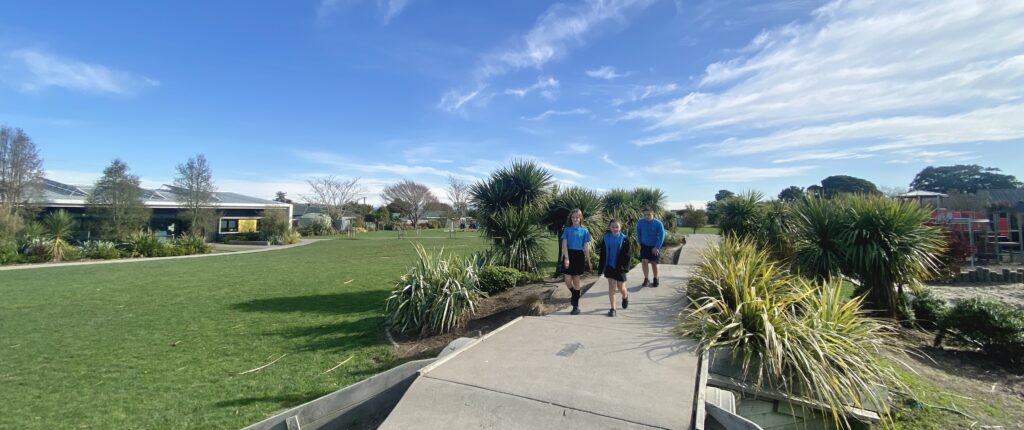Nau mai, haere mai ki te kura o Waitākiri
At Waitākiri Primary School we continue to foster a safe and supportive environment where positive relationships and behaviours are valued and ākonga, kaimahi and whānau are empowered to be REAL Heroes making REAL CHOICES.
This is our kaupapa – our story
Ngāi Tahu trace their tribal identity back to Paikea, who lived in the Polynesian homeland of Hawaiki. To escape being killed at sea by his brother, Paikea came to New Zealand on the back of a whale. Ngāi Tahu share this ancestor with the Ngāti Porou people. One of Paikea’s descendants was Tahu Pōtiki, from whom Ngāi Tahu take their name. Tahu Pōtiki lived on the East Coast of the North Island.
From the East Coast, Ngāi Tahu migrated south to Te Wai Pounamu. Te Wai Pounamu, the greenstone waters, was named after the beautiful and valuable stone found on the West Coast. As Ngāi Tahu moved down the island, they fought several battles with two tribes already living there – Ngāti Māmoe and Waitaha – and eventually made peace and intermarried. By the end of the 18th century, Ngāi Tahu had reached Foveaux Strait, at the bottom of the South Island, and had occupied the West Coast. Te Potiki Tautahi was one of the original Ngāi Tahu people to settle in the Canterbury region. His settlement was at Koukourarata (Port Levy) on Horomaka (Banks Peninsula). At that time, the swampy flatlands of the present day site of Christchurch city were abundant with food such as ducks, weka, eels and small fish. The area now known as Christchurch was originally called Ōtautahi, meaning ‘the place of Tautahi’.
The early Māori settlers traded in furs, seafood, bird life and harakeke, and quickly established trading relationships with the European settlers. The land around Burwood was originally wetlands and sand dunes. In this area Māori fished for tuna (eel) and ika (fish), and trapped Kererū (wood pigeon) in a landscape that looked more like swamp, wetlands and streams than the landscape we have today. Ōruapaeroa Pā, in the Travis Wetlands vicinity, and Te Oranga Pā at Waikākāriki (Horseshoe Lake) were seasonal pā sites used in the warmer months.
Waitākiri Primary School is located in the area of the hapū, sub tribe of Ngāi Tūāhuriri, based at Tuahiwi. Appropriately, the new school was blessed by the late Rakiihia Tau, Upoko chief of Ngāi Tūāhuriri, when the merged schools became one on Monday the 3rd of February 2014.
The first Europeans landed in Ōtautahi in 1815 with significant settlement following in 1840. During 1850, the first major planned settlement by the Canterbury Association occurred with the arrival of the four ships into Lyttelton. The Charlotte Jane arrived on Monday the 16th of December 1850 and was followed in the next few hours and days by the Randolph and Sir George Seymour, with the Cressy being the last to arrive on December the 27th. The ships carried 800 passengers with a mix of colonists and settlers; those with money to buy land and those who would work for the colonists. The new economy emerging in Christchurch was sheep farming, with wool in high demand internationally. Christchurch soon became a large and prosperous city with the population in the South Island outstripping the North Island for many years.
As Christchurch grew, the Avon River was used for food and transport and the surrounding land was utilised for grazing and market gardening. With rapid population growth, the east became more popular, despite the wind and the swampy land. The wetlands were drained, the rivers were defined by banks and the wind was mitigated by continued plantings.
The area of Burwood was named by George King, an early settler in the area. He had lived in Sydney where his property was called ‘Burwood’.
In 1872, Burwood Primary School opened, first known as New Brighton Primary School. In February 1889, the school operated on dual sites with the opening of the New Brighton ‘side school’ named Beach School. In April 1889, New Brighton Primary School was renamed Burwood Primary School and Beach School was renamed New Brighton Primary School. Burwood Primary School went from strength to strength over the years with the roll exceeding 500 children. In the late 1960’s the ongoing growth in the area led to the need for a new school and in 1970 Windsor Primary School opened.
Both schools continued to grow over the years and by the time of the devastating earthquakes of 2011, the schools had a combined history of 180 years and over 1000 students!
The earthquakes left 60% of the Burwood Primary School zone uninhabitable and designated ‘red zone’. This had a devastating impact on the community and the school, more than halving the roll overnight. Following the earthquakes, the Minister of Education made the decision to merge the schools onto the Windsor site.
In 2014 Waitākiri Primary School was created from the merger of Windsor Primary School and Burwood Primary School. Waitākiri, meaning ‘meandering waters’, is a very fitting name for a school built on lands where the ocean, rivers, streams, swamps and lakes have played such an important role in how the land has been used and developed. While the new school was being constructed, Waitākiri Primary School operated on dual sites with Burwood Primary School renamed River Campus and Windsor Primary School renamed Wetlands Campus, recognising the unique locations of the two schools.

Waitākiri Primary School has a history to be proud of. The wind and water have formed and shaped the whenua/land and the earthquakes have now redefined land use. The land has been a rich resource for all people who have lived in or utilised the area for food, travel and recreation. Burwood Primary School was one of the oldest schools in Canterbury, and together with Windsor Primary School, had a strong and positive community spirit. The new school will honour the first Māori settlers, the European early settlers, and both Burwood and Windsor Primary Schools.
The physical design of our school (including buildings, landscaping, colours and artefacts) honours our past, as we forge a positive future together.
The themes that continue to define the school are whenua (the land), wai (water) and rangi (sky). The landmarks and features that link to the identity of our school include Otākaro, Travis Wetlands, Mt Cavendish (the maunga most visible from both campuses), and both the Ruru (owl) and Korimako (bellbird), the native birds of the area.
New entrant tamariki transition into school through the Whenua (Land) community, named Windsor and Burwood in recognition of our history as well as marking the beginning of their journey at Waitākiri Primary School. Within this community, the children’s learning focusses around the context of land/whenua, thus developing within the children, a sense of belonging to our unique place, our tūrangawaewae. From here they transition to Travis or Ōtākaro (Year 3 & 4), with water providing the context for their science focussed inquiry. The tamariki then finish their time at Waitākiri Primary School in Ruru or Korimako (Year 5 and 6), with the air, the sky and beyond providing their science learning context.
This transitioning between communities will enable Waitākiri children to develop a sense of belonging, their tūrangawaewae, knowing where they stand, their place. From knowing the place in which they stand, our tamariki will confidently connect with the wider world.
Throughout their six years, children will encounter a wide range of learning opportunities from other topical inquiries, to numeracy, literacy, the arts, technology, social sciences, health and physical education. Interwoven with the curriculum are the unique Waitākiri Primary School values, enabling the children to become REAL Heroes making REAL CHOICES (Respectful, Encouragers, Achievers and Lifelong learners); individuals who will have the skills to create a sustainable, collaborative and positive future for themselves and their communities. CHOICES, represents values important to the school community as the two schools became one. CHOICES: Community, Hauora, Opportunity, Innovation, Collaboration, Enjoyment and Sustainability.

170 Burwood Road, Burwood, Christchurch 8083
© 2021 Waitākiri Primary School. Website Design by Blake